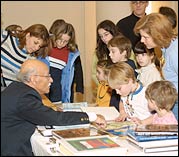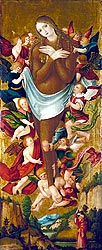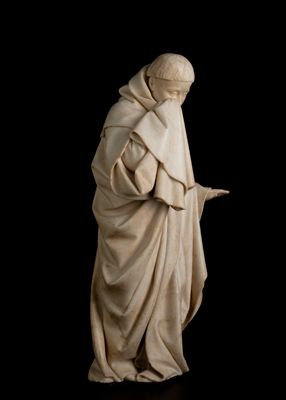Now, the reason for this particular favoritism has a little to do with the quality of the art itself (though, it's astonishing) but has more to do with the relationship I've had with this museum over the years. It's where we took our Elementary School field trips. It's where I once went on dates when we were past the mini-golf stage but weren't yet of drinking age. It's where I took my kids when they were little and we just needed to get out of the house.

The MIA has, over the years, worked hard to make itself an inclusive place, to democratize art - it's free, for one; it has a play room and programming for children; it features free tours and lectures and music on Sunday mornings and hands-on art projects that parents can pretend are for their children to do, but secretly enjoy that odd satisfaction of decoupage and clay and tempura paints.
So, I love this museum. And I try to come over here at least once a month. But I do so on my own, on the sly and for my own particular reasons.
I come to the institute because it makes me a better writer.
It started out with one painting. (Doesn't it always?) Once, when I was much younger than I am today, I came to the museum on a date with a young man who was, let's face it, something of a dud. No imagination, no spark. Hot? Yes. Smart? Not so much. Since he wasn't much for conversation, I focused my attention on the art. And then I saw her.
Lucretia. Despite the fact that her story has been told and re-told by men (always men) - her resistance to Titus, her refusal to allow herself to be made a pawn, her suicide, not as acquiescence, but as defiance to the perversions of power - no matter who is telling the story - Shakespeare, Chaucer, Heywood, St. Augustine, and Livy, to name just a few - the person of Lucretia remains: The woman who stood up for herself, who called rape what it was, and by her death, spawned a revolution, a government, a republic, and a new way of life.
Go Lucretia.
And this painting, when she is standing in front of her husband and father, when the knife is still wet with her blood and her tears shimmer at the rims of her eyes - I know that Rembrandt gets her. Go Rembrandt.
So I kept coming back, always to see Lucretia. And her voice has whispered in my work - her defiance, her impatience with power, her willingness to hold wrongdoers accountable, even if her own death was a requirement to move the wheels of justice - has insisted its way into my pages again and again.
And it isn't just Lucretia. Given that I am not a visual artist, and never could be, and despite the fact that I am not a visual thinker at all, I am still thrilled by the visual arts. The hands that lovingly carved Saint Catherine of Alexandria, for example:

have made their way into a story that I'm working on now. Notice the man she's standing on. Notice the serenity on her face as she presses him into the ground. I've always been a big fan of Saint Catherine (despite the fact that most folks tell me that she likely didn't exist. I don't care. In my heart she existed, and continues to exist, so really, isn't that enough?) and I absolutely love this statue. In my story, my heroine has a very specific reason to portray these two people in this - ahem - rather compromising position. More on that later.
And the painting of this panel:  found its way into one of my stories a number of years ago. Currently, there's an exhibit that's on tour called "The Mourners", which were originally carved for the tomb of John the Fearless in Dijon, France.
found its way into one of my stories a number of years ago. Currently, there's an exhibit that's on tour called "The Mourners", which were originally carved for the tomb of John the Fearless in Dijon, France.
 found its way into one of my stories a number of years ago. Currently, there's an exhibit that's on tour called "The Mourners", which were originally carved for the tomb of John the Fearless in Dijon, France.
found its way into one of my stories a number of years ago. Currently, there's an exhibit that's on tour called "The Mourners", which were originally carved for the tomb of John the Fearless in Dijon, France. These statues are delicate, heartbreaking and utterly, utterly thrilling. Each one demonstrates his grief in his own particular fashion, and each one communicates that grief to the viewer through gesture, stance and expression. And it isn't the individual expressions of grief that is so stunning to me. Rather, it is the assertion that grief is a communal emotion. Grief is something we share, it is something we burden one another with, and by burdening, release one another as well. I stood in front of these statues, transfixed, hardly breathing, my mouth and eyes wide open and astonished.
These statues are delicate, heartbreaking and utterly, utterly thrilling. Each one demonstrates his grief in his own particular fashion, and each one communicates that grief to the viewer through gesture, stance and expression. And it isn't the individual expressions of grief that is so stunning to me. Rather, it is the assertion that grief is a communal emotion. Grief is something we share, it is something we burden one another with, and by burdening, release one another as well. I stood in front of these statues, transfixed, hardly breathing, my mouth and eyes wide open and astonished.I'll probably be back tomorrow.
I will probably steal . . . something. A shrug, a turn of the neck, a delicate unfurling of the hand, and sneak it into a story. More as that develops.
So here's my question for the lot of you: What are the museums or paintings or sculptures that call out to you? What pieces of art has fed you as a writer or a reader or just as a person?







2 comments:
I love that: "by burdening, release one another as well."
These days I find myself staring at my children's art a lot, but getting something extra from it, too. Over the summer, we we went to the Rockwell exhibit where every picture told a story. Back in the day I used to spend hours staring at record covers, when they were big enough to see. I don't have a piece I keep going back to, but museums where I always leave with inspiration include the National Portrait Gallery and the Visionary Art Museum. http://www.avam.org/
Oh I LOVE the National Portrait Gallery! It's amazing how evocative the human face is - all those tiny muscles, every stress line and wrinkle telling its own story. I love that.
I'm also deeply fed by the Surrealists - but I tend to swing that way in general.
Post a Comment